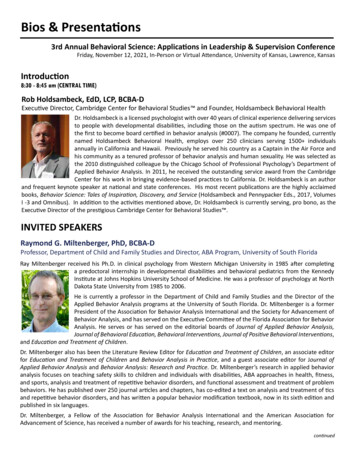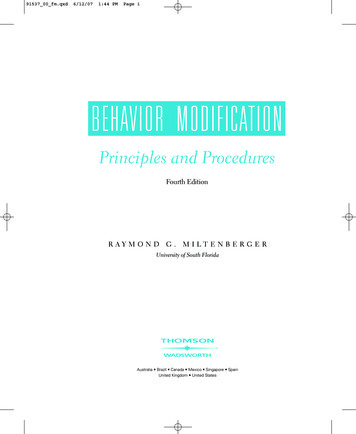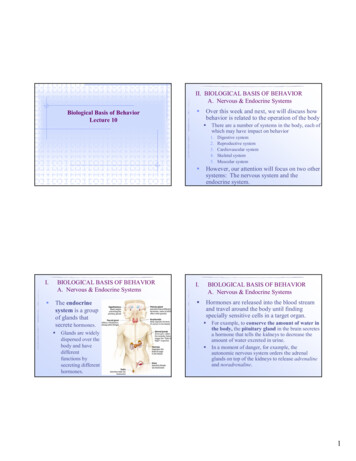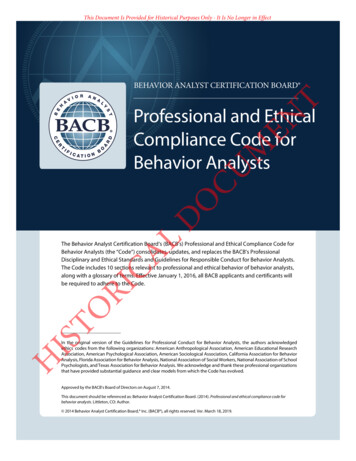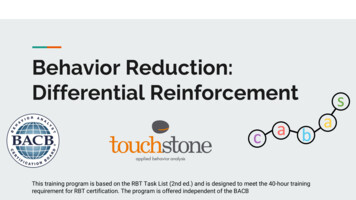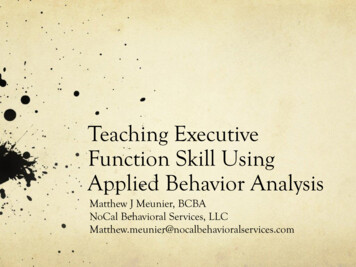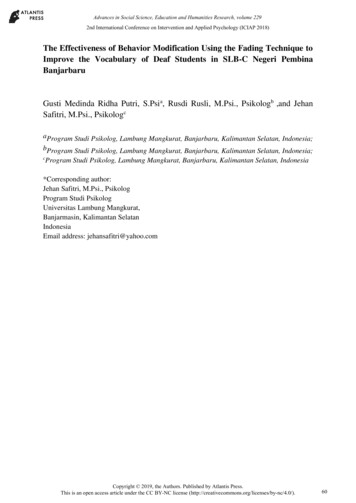
Transcription
Advances in Social Science, Education and Humanities Research, volume 2292nd International Conference on Intervention and Applied Psychology (ICIAP 2018)The Effectiveness of Behavior Modification Using the Fading Technique toImprove the Vocabulary of Deaf Students in SLB-C Negeri PembinaBanjarbaruGusti Medinda Ridha Putri, S.Psia, Rusdi Rusli, M.Psi., Psikologb ,and JehanSafitri, M.Psi., PsikologcaProgram Studi Psikolog, Lambung Mangkurat, Banjarbaru, Kalimantan Selatan, Indonesia;bProgram Studi Psikolog, Lambung Mangkurat, Banjarbaru, Kalimantan Selatan, Indonesia;cProgram Studi Psikolog, Lambung Mangkurat, Banjarbaru, Kalimantan Selatan, Indonesia*Corresponding author:Jehan Safitri, M.Psi., PsikologProgram Studi PsikologUniversitas Lambung Mangkurat,Banjarmasin, Kalimantan SelatanIndonesiaEmail address: jehansafitri@yahoo.comCopyright 2019, the Authors. Published by Atlantis Press.This is an open access article under the CC BY-NC license 0
Advances in Social Science, Education and Humanities Research, volume 229The Effectiveness of Behavior Modification Using the FadingTechnique to Improve the Vocabulary of Deaf Students in SLB-CNegeri Pembina BanjarbaruAbstract-- Various problems can arise when individuals interact with individuals withdisabilities, especially when one of them is deaf. Being deaf and having hearing loss areconditions in which the individual loses hearing function completely or partially.Generally, the problem faced by an individual when interacting with the deaf is thedifficulty communicating because the deaf are unable to communicate well, which iscaused by obstacles in language development. The delayed language development of thedeaf is preceded by the limited number of vocabulary words known by individuals withhearing loss, result in a delay in learning the structure of sentences. Developing anintervention program to improve the vocabulary of the deaf is critical, and it can beapplied to the deaf as early as possible to develop deaf communication skills and addressthe problems of individuals or other parties who interact directly with the deaf. Thisresearch uses the fading technique, one of the behavior modification techniques used byreducing the prompt bit by bit until the prompt is no longer needed to reach the learninggoal. Fading in this study was conducted by applying fading to the writing and verbalprompt given while teaching a new vocabulary word to the subject. An interventionprogram using a flash card and a name card was performed for 1 month, once per week,with a maximum duration of 60 minutes per meeting. This study aims to assess theeffectiveness of behavior modification using the fading technique to improve thevocabulary of deaf students in SLB-C Negeri Pembina Banjarbaru. The samplingtechnique used in this study was purposive sampling, and the criteria were children whohave a severe level of hearing loss and have the ability to recognize letters and writing.Based on the sampling process implemented, three subjects were obtained, namely, Alaged 9 years, N aged 10 years, and Am aged 9 years. The data collection technique wasconducted using observation and interview techniques. Observation was performed byobserving the subject’s vocabulary knowledge before and after the given interventionprogram, and the interview was conducted with the parents and the teacher of the subjectto obtain a general description of the subject. The data collected through observationsbefore and after the intervention program were analyzed using the Wilcoxon signed-ranktest, and this test was supplemented by other analyses using categorization, gain scores,and a comparison of subject’s average before and after the application of the interventionprogram. Based on the Wilcoxon signed-rank test analysis, the value of Z arithmetic wasequal to 1,604, and through a calculation using a significance level equal to 0,1 a Ztable equal to 0,05 was obtained, which means it has a point of coordinate 0,13. Havingcreated a normal curve with a Z arithmetic point and a Z table to enforce the hypothesis,an observation is that the score of the Z arithmetic is in the rejection rate of H0.Categorization was performed on the subject's pretest and posttest score: Al scored 1, Nscored 4, and Am scored 6; thus, all the pretest results of all the subjects were in the lowcategory. During the posttest, Al scored 21, N scored 30, and Am scored 22; thus, all theam posttest results of the three subjects were in the high category. The gain scores wereas follows: Al scored 20, N scored 26, and Am scored 16. The mean of the pretest scorewas 3,67 and increased to 24,33 on the posttest. Based on the results of this study, aconclusion is that the behavior modification using the fading technique is effective toimprove the vocabulary of deaf students at SLB-C Negeri Pembina Banjarbaru.61
Advances in Social Science, Education and Humanities Research, volume 229Keywords: behavior modification, fading, vocabulary, deafIntroductionVarious problems can arise when individuals interact with individuals with disabilities, forexample, when one of whom is deaf. Hearing loss or hearing impairment is a condition wherethe individual loses hearing function in such a manner that the individual cannot capturevarious stimuli, especially through the sense of hearing (Somantri, 2012). Mangunsong (2014)classified deafness based on severity, namely, mild hearing loss is between 20 and 40 dB,moderate hearing loss is between 41 and 60 dB, severe hearing loss is between 61 and 90 dB,profound hearing loss is between 91 and 120 dB, and total hearing loss is more than 120 dB.An inter-census population survey of the Indonesian population in 2015 described 6,952,797Indonesians aged 10 years and over who have experienced hearing loss, including 178,613residents who were deaf, 1,180,722 residents with severe hearing loss, and 5,593,462 residentswith mild hearing loss category. The survey was also conducted at the provincial level. In theprovince of South Kalimantan, there were 78,348 people aged 10 years and over whoexperienced hearing loss, including 2,090 residents who were deaf, 11,562 residents withsevere hearing loss, and 64,732 residents with mild hearing loss category (Badan PusatStatistik, 2015).Santrock (2010) asserted that deaf people from birth and after birth tend to be weak inspeaking and language skills because they do not have media to develop their social,emotional, and intellectual aspects. Somantri (2012) mentioned that in the social aspect,people with hearing loss feel anxiety and experience conflict, confusion, and fear because theyface a diverse environment of communication. Regarding the emotional aspect, people withhearing loss have difficulty understanding spoken or written language, which often causes theindividual to misinterpret something; thus, the individual feels emotional pressure, which isusually manifested through an attitude of self-closing, acting aggressively, and showingconfusion.Sugiarti (2015) asserted that 5th grade of deaf students in SLB (more than 85%) haddifficulties with vocabulary mastery and correctly pronouncing Indonesian vocabulary.Parmawati, Prasetyawati, and Prianto (2015) asserted that the delay in language developmentof deaf children begins with the limited number of vocabularies known by these children,resulting in delays in learning sentence structure. Based on this explanation, an observation isthat people with hearing impairment have difficulty in mastering vocabulary; thus, people witha hearing impairment must be able to improve their vocabulary so that they can develop whenstudying sentence structure.Psychologist has a special approach to applying learning methods to individuals with specialneeds. Rusch (in Miltenberger, 2012) asserted that behavior modification has a major role indeveloping teaching methods in special education. One behavior modification technique is62
Advances in Social Science, Education and Humanities Research, volume 229fading. Miltenberger (2012) asserted that fading is a gradual elimination of the prompt becausebehavior consistently appears during the presence of a stimulus. With fading, the stimulus nolonger depends on the prompt to bring about the expected behavior.An example of the application of the fading technique is as follows. A teacher helps one of thestudents improve her or his vocabulary with the help of a flash card on which there is a pictureand description of the name of the picture, for example, a picture of a car (as a flash card) andthe word “car.”Car flash cards with the word car act as a stimulus that produces the desired behavior, that is,students can say simple vocabulary words, such as the word car, and finally receive praisefrom the teacher. When students do not show the desired behavior by not responding when theteacher shows a car flash card, the teacher provides encouragement with a verbal prompt bysaying the word “car” when showing the car flash card; thus, that student can say “car”(Miltenberger, 2012).Furthermore, the fading technique is conducted by gradually eliminating the prompt given bythe teacher. For example, the car flash card is shown to the student with several attempts.These attempts start with reducing the prompt until the prompt is eliminated by showing onlythe car flash card; notably, the student will still able to say “car,” and finally, the stimulus canproduce the expected behavior without prompts (Miltenberger, 2012).Two studies in Indonesia have used fading techniques to improve vocabulary, namely,“Application of Behavior Modification Procedures with Token Economy and FadingTechniques to Increase the Vocabulary of Autistic Children in Dorkas Kakas SLB” byPunusingon, Nurhamidin, and Dapa (2013) and “The Effectiveness of Behavior ModificationApproach with Fading and Token Economy Techniques to Increase the Vocabulary ofPrelingual Profound Deaf student” by Parmawati et al. (2015). Based on the two studies thathave been conducted, the fading technique is effective for increasing vocabulary.Researchers have conducted a preliminary study of subjects comprising three deaf students inthe SLB-C Negeri Pembina Banjarbaru. The preliminary study was conducted using themethod of observation and interview with Mrs. B, the subject's teacher, and the subject'sparents. All the subjects were students the in 3rd grade, deaf, and in class B (a specifically deafclass) at SLB-C Negeri Pembina Banjarbaru. The three subjects were Am, a female aged 8years; N, a female aged 10 years; and Al, a male aged 9 years.The preliminary study was conducted on October 26th, 2017. The three subjects were observedto be active, able to communicate with researchers by reading lip movements that weresometimes supplemented with sign language, and able to read per syllable. When speaking,the three subjects were able to produce words that could not be heard clearly. The threesubjects seemed to communicate more easily than other students in class B because these otherstudents were able to produce only vowels accompanied by very slow intonation or evenshouting, which made communication difficult except when using sign language.63
Advances in Social Science, Education and Humanities Research, volume 229The teacher asserted that different methods have been used to introduce a word related to asubject: The teacher had presented the object in question with lips and a clear voice and hadalso shown pictures. The teacher explained that showing pictures to the subject often resultedin the subject being unable to recognize the actual object because it was different from thepicture shown, but showing pictures was the easiest method to implement. Parents also haddifficulties introducing words, and the only means parents used to introduce words is showingthe object directly.Based on the aforementioned explanation, researchers have been interested in applyingbehavior modification using fading technique to improve vocabulary in deaf students. Thisstudy focuses on improving vocabulary through the identification of vocabulary. Notably,because the subjects have limitations when speaking, the indicator of success in this study isthe subjects’ process of identifying the vocabulary that can be correctly done and written bythe subject, instead of pronunciation. The vocabulary introduced to the subjects is a noun on alist of sight words. Sight words are a type of vocabulary that children easily recognize, arevery common, and need to be introduced from the beginning because it is the basis ofreading.MethodsThe research design used in this experiment was quasi-experimental. Jones and Forshaw(2012) mentioned that a quasi-experiment is a type of research very similar to actualexperiments that does not have all the characteristics required in actual experiments. A quasiexperiment is experimental research that includes several types of interventions or treatmentsand provides an overview of the comparison; however, the level of control in this type ofexperiment is insufficient to be classified as an actual experiment. The quasi-experimentaldesign used in this study is one-group pretest–posttest design, that is, the research is conductedby measuring the behavior of a group before and after the treatment given in the experiments(Shaughnessy, E. B. Zechmeister, & J. S. Zechmeister, 2011).Seniati, Yulianto, and Setiadi (2009) mentioned that in the one-group pretest–posttest design,at the beginning of the treatment, the first step is the measurement of the dependent variablepossessed by the subject; after the treatment is given, the second measurement of thedependent variable is performed by using the same measuring instrument. The effectiveness orinfluence of the independent variable on the dependent variable can be observed through thedifference between the pretest and posttest results. If the posttest result is higher than thepretest, a conclusion is that the independent variable (in the form of treatment) can increasethe dependent variable. This study used this design to conduct a comparison before and afterthe given the behavior modification treatment, namely, the fading technique, by comparing thepretest and posttest scores of one subject group that comprised three deaf students.The sampling technique in this study uses purposive sampling technique. Sugiyono (2011)mentioned that purposive sampling is the technique used to determine the sample in a studybased on certain considerations that are suitable for research and do not have to be64
Advances in Social Science, Education and Humanities Research, volume 229generalized. This technique is used because researchers need subjects with the same criteria sothat the program provided can be accepted by all subjects. The criteria for the subjects in thisstudy were as follows: severe level hearing loss (i.e., 61–90 dB) and the ability to recognizeletters and writing.In this study, the intervention program was conducted using flash cards and name cards. Theintervention program was conducted over four, 60-minute meetings to teach 15 newvocabulary words: “punggung,” “kasur,” “perahu,” “kursi,” “jagung,” “boneka,” “pintu,”“api,” “lantai,” “kertas,” “babi,” “cincin,” “domba,” “tupai,” “jendela.”The steps for each meeting session are as follows: Stimulus (flash card) complete prompt (full writing of the object’s name on the namecard, and the full verbal prompt of the object's name on the name card from theresearcher) The subject was asked to write the name of the object on the flash card If the first step was successful, the subject was given social reinforcement, ifunsuccessful, this step was repeated. Stimulus (flash cards) fading prompt (half of the object's name on the name card andsome verbal prompts) The subject was asked to write the name of object on the flashcard If the second step was successful, the subject was given social reinforcement, ifunsuccessful, the sequence was started again with first step. Stimulus (flash cards) fading prompt (the first letter of the name of the object on theflash card, and the verbal prompt by pronouncing the first letter of the object’s namefrom the researcher) The subject will be asked to write the name of object on theflash card If the third step is successful the subject was given social reinforcement, ifit is not successful back to the second step. Stimulus (flash card) without prompt The subject is asked to write the name of objecton the flash card If the last step was successful, the subject was given socialreinforcement, if unsuccessful, the steps 1, 2, and 3 are repeated (depending on thesubject's ability).Data collection techniques used in this study were observation, interview, and audiometry test.Observation was the main technique, and the interviews and audiometry tests were forcollecting complementary data, namely the general description of all the subjects, which wasobtained by interviewing the subject’s parents and the teacher. The audiometry tests wereperformed to confirm the level of the subject’s hearing loss.The researchers performed observations and used a checklist on paper to facilitate the process.The same tests were used for the pretest and posttest and contained new vocabulary words thatthe subject had to learn. When a subject wrote the new vocabulary, the researcher scored thetask as 1 for the correct answer and 0 for the wrong answer. Research data obtained from thepretest and posttest results were analyzed using the Wilcoxon signed-rank test. As mentionedby Riadi (2016), if the value of Z is in the rejection of H0, H0 is rejected; thus, the fading65
Advances in Social Science, Education and Humanities Research, volume 229technique can improve the vocabulary of deaf students (there are differences in the vocabularyof the deaf students before and after the application of the technique fading).Validity testing used in this study used content validity by using expert judgment. Azwar(2012) asserted that expert judgment is the agreement of several experts competent in theirfield, and if most of the experts agree, the scale item on the research measuring instrument isrelevant, and the item is then feasible to be used as a measuring instrument in research. Theitem in this study is 15 vocabulary words that had been assessed by four experts: two clinical,development, and education psychologists, and two teachers for students with special needs atSLB-C Negeri Pembina Banjarbaru.Reliability in this study was conducted using inter-rater reliability techniques. Azwar (2012)observed that researchers use rating techniques, namely, the procedure of scoring based onsubjective judgments on certain aspects or attributes, which are conducted by direct orindirect observation. To minimize the influence of subjectivity on the scoring, the assessmentprocedure is conducted with more than two people, and this assessment process is referred toas inter-rater reliability. In this study, two assessors, namely, two psychology students of theUniversity of Mangkurat in their 8th semester, also acted as observers. The assessors wereprovided instructions on the scoring procedure. Regarding the implementation of inter-raterreliability, the total number of observers in this study was three, namely, one of theresearchers and two other observers, so that the observations of the researcher could be easilycompared with the results of the other observers.ResultThis research was conducted for approximately 1 month: April 1 to April 25, 2018. In thisstudy, the measured data was data from the results of the pretest and posttest and wascategorized according to the research categorization that has been determined. Table 1presents the data categorization of the pretest results of the three subjects:Table I. Distribution of Data Categorization (Pre-Test)FrequencVariableValue RangeCategoryPercentageyVocabulary0 10Low3100%Knowledge10 20Medium20–30High-In Table 1, all subjects are in the low category; thus, all subjects have low vocabularyknowledge. Table 2 presents the categorization of the data of posttest results of three subjects:Table II. Distribution Data Categorization eRangeVocabulary0 10LowKnowledge10 20Medium20–30High3100%66
Advances in Social Science, Education and Humanities Research, volume 229In Table 2, all subjects are in the high category; thus, all subjects have a high vocabularyknowledge. Table 2 also shows that after the implementation of the intervention program toimprove vocabulary using the fading technique, all subjects experienced increases. In thebeginning, the pretest scores indicated that all the subjects were in the low category; at the endof the study, the posttest scores increased to the high category.This result is in accordance with the assertion from Parmawati et al. (2015): behaviormodification approaches with a token economy and fading techniques are effective atincreasing vocabulary in prelingual profoundly deaf learners. Parmawati et al. (2015)combined token economy techniques and fading to improve the vocabulary of deaf students,but this study concluded that the fading technique can also be effective for improving thevocabulary of deaf students.In the three subjects, differences were observed between the pretest and the posttest results(gain score), which are addressed in Table 3:Table III. Subjects’ Gain Score on Pre-Test and Post-TestNo. Name Gender Pretest Posttest Gain Score123AlNAm403020100Fig. 1.LPP14621302220261622Pretest30211Subjek AlSubjek NPosttest64Subjek AmComparison Graph of Subjects’ Pretest and Posttest ResultData were obtained during the pretest and posttest and then analyzed by using the Wilcoxonsigned rank to assess if the two samples were paired, but in only the control group. The twopaired samples in this study were the results of pretest and posttest for the subjects, and for thecontrol group, the three subjects of the study. In carrying out the signed Wilcoxon-rank test,the researcher compared the calculated Z and Z table value. When the value of calculated Zwas in the rejection area of H0, Ha was accepted, and vice versa. Table 4 presents the results ofthe Z count obtained with the help of the IBM SPSS Statistics 23 computer program:Table IV. Result of Wilcoxon Signed-Rank TestNPretest - PosttestNegative RanksPositive RanksTiesTotal0303MeanRank0,002,00Sum of Ranks0,006,0067
Advances in Social Science, Education and Humanities Research, volume 229ZAsymp. Sig (2tailed) 1,6040,109In this analysis, the value considered is the Z value with α 0.1 (10%). If calculated Z is in thereception area of H0, H0 is accepted, and if calculated Z is outside the reception area H0, H0 isrejected. The formula for calculating Z tables is as follows:The Z table value obtained is 0.05, which means it has a coordinate point of 0.13 whenreferring to a Z table for a normal curve. Based on the value of calculated Z and the Z tablethat has been obtained, an observation is that the value of calculated Z ( 1.604) is in theregion of rejection of H0. The results of this statistical analysis are illustrated in Figure 2:H0 RejectionAreaFig. 2.H0 ReceptionAreaH0 RejectionAreaRejection and Reception Area of H0The results of the analysis using the Wilcoxon signed-rank test indicate that the calculation ofthe value of the Z count of 1.604 is in the rejection area of H0 after making a curve with theZ coordinates of the table by 0.13. This result means that there are differences in vocabularyin the subject before and after the implementation of the fading techniques. From the severalanalyses that were performed, a conclusion is that there are differences that lead to anincrease in the subjects’ vocabulary knowledge before and after the subject is given treatmentusing the fading technique.DiscussionThis discussion also answers the research question by providing results that indicate that theimplementation of behavior modification using fading techniques is effective to improvevocabulary in deaf students of SLB-C Negeri Pembina Banjarbaru. Parmawati et al. (2015)68
Advances in Social Science, Education and Humanities Research, volume 229used fading techniques to increase the vocabulary of deaf subjects diagnosed with a profoundlevel of hearing loss. Based on the results of this study, the fading technique can also beeffectively applied to improve the vocabulary of deaf subjects with a severe level of hearingloss.Fading techniques can be applied effectively and cannot be separated from the age factor of allthe subjects, who were in late childhood. Santrock (2011) asserted that in middle and latechildhood, there is an increase in memory that reflects an increase in knowledge in children.The task of the subject in the application of this intervention program is to remember the newvocabulary shown through a flash card; because of the process of improving memory in latechildhood, the subject is helped to complete the task to remember the new vocabulary.There is a unique dynamic between one subject and another subject. Am subjects were aged 8years, and an increase in vocabulary knowledge scores was observed after the interventionprogram implementation of 16. Subjects aged 9 years obtained an increase in vocabularyknowledge scores after the intervention program implementation of 20. Subject N was 10 agedyears and an increase in vocabulary knowledge scores was observed after the application ofthe program intervention amounted to 26. When observed carefully, the increase that occurredwas greater in the subjects older than the other subjects. This result can be understood byreferring to Santrock (2011), who asserted that older children compared with younger childrenare usually more skilled and have a better memory.In this study, if the subject cannot complete the steps in the fading technique, it is repeated inthe previous stage until the subject makes no mistakes. The repetition conducted in this studyis in accordance with the memory method. Febriana, Rahmah, and Erlyani (2012) asserted thatthe memory method is a method of memory research that examines the extent of the timeneeded by the subject to be able to master material that is well studied. More specifically, therepetition method is a type of memory method, which is a method of re-learning. The relearning method asserts that the more often material is learned, the more material that can beremembered well, and the less material is forgotten.When implementing the intervention program in this study, the researchers used socialreinforcement as an amplifier. Sometimes when implementing an intervention program, thesubject looked upset and wanted to give up when mistakenly remembering the vocabulary at acertain step; in this situation, the researchers always provided support and encouragement sothat the subject would continue to attempt to remember the new vocabulary the subject islearning. In addition, the researchers always provided positive social reinforcement when thesubject was able to remember the new vocabulary well and avoided negative reinforcement orpunishment when the subject could not remember the new vocabulary. Social reinforcement isa type of reinforcement effective in facilitating the successful implementation of interventionprograms. Martin and Pear (2015) stated that one of the social reinforcers in the form ofattention from others is a very strong amplifier for almost everyone. One example of socialreinforcement is praise, which is positive and effective reinforcement used to strengthen andmaintain appropriate behavior in everyday life.69
Advances in Social Science, Education and Humanities Research, volume 229This study has limitations. The first limitation is a higher significance value of 0.009 than theinitial significance value that had been determined; this was likely due to the limited numberof subjects in this study, namely, three subjects. In addition, it is difficult to find subjects withthe same level of hearing loss; if the subject does not have references as a reference level ofthe hearing loss experienced by the subject, the researcher must perform audiometry tests onseveral children to find children with the same hearing loss level that matches the researchsubject category. Additionally, the researchers observed that the obstacles to implementingthe intervention programs were substantial because building communication with childrenwith special needs, especially deaf children, is different from that process with normalchildren; thus, the researchers realized that they required a higher level of competence to beable to maximize the application of intervention programs in this study.ConclusionBased on the categorization of data, an observation is that after the implementation of theintervention program, all the subjects’ scores increased. Initially, in the pretest stage, all thesubjects were in the low category; then, in the posttest stage, all the subjects were in the highcategory. The gain score obtained by Al, N, and Am was 20, 26, and 16, respectively. Thecomparison of mean shows an average increase of 20.66 in the posttest value of all subjectscompared with the pretest value, which means that the subjects’ vocabulary knowledge washigher after the treatment (i.e., applying fading techniques to improve vocabulary). TheWilcoxon signed-rank test demonstrated that the significance level was 0.109, which isgreater than 0.009 from the level of significance of the research previously determined by0.1. Nevertheless, the research that remains rejected the H0 and referred to the value ofcalculated Z research is 1.604, and the value of the Z table is 0.13, which means the value ofcalculated Z is in the region of rejection of H0, which means Ha is accepted. Based on severalanalysis techniques conducted by the researchers to answer the research questions, aconclusion is that the behavior modification us
needs. Rusch (in Miltenberger, 2012) asserted that behavior modification has a major role in developing teaching methods in special education. One behavior modification technique is Advances in Social



